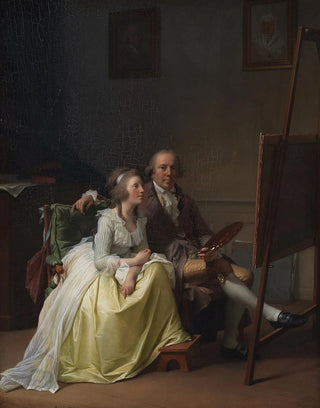Art print | L'artiste et sa femme Rosine née Dröschel - Jens Juel


View from behind

Frame (optional)
In the fascinating world of art, certain works stand out for their ability to capture the very essence of human relationships. "The Artist and His Wife Rosine née Dröschel" by Jens Juel is one of those creations that transcend a simple portrait to become a true ode to love and complicity. Created in the 18th century, this piece still resonates today, bearing witness to an era where intimacy and sensitivity were at the heart of artistic concerns. Through this painting, Juel invites us to immerse ourselves in a moment of life, where each exchanged glance between the two protagonists tells a unique story.
Style and uniqueness of the work
Jens Juel's style is characterized by finesse in execution and particular attention to detail. In "The Artist and His Wife Rosine née Dröschel," one can observe a palette of delicate colors, where soft hues blend harmoniously to create a warm atmosphere. The features of the faces are carefully outlined, revealing not only the physical characteristics of the characters but also their personalities. The posture of the two figures, slightly leaning towards each other, evokes a palpable closeness and tenderness. Juel thus manages to capture not only appearance but also emotion, making this work a true tableau of feelings. The subtly balanced lighting highlights the textures of clothing and skin, adding an almost tangible dimension to the scene.
The artist and his influence
Jens Juel, a Danish painter of the 18th century, is often recognized as one of the masters of portraiture in Scandinavia. His work is set within an artistic context where the representation of individuals took a prominent place, marking a transition towards more intimate styles. Juel was able to draw inspiration from European currents while adding his personal touch, notably through his skill in conveying the psychology of the characters. His influence endures, not only through his works but also through the artists who followed in his footsteps, seeking to explore the depth of human relationships through the lens of painting. In "The Artist and His Wife Rosine née Dröschel," he does not merely depict

Matte finish

View from behind

Frame (optional)
In the fascinating world of art, certain works stand out for their ability to capture the very essence of human relationships. "The Artist and His Wife Rosine née Dröschel" by Jens Juel is one of those creations that transcend a simple portrait to become a true ode to love and complicity. Created in the 18th century, this piece still resonates today, bearing witness to an era where intimacy and sensitivity were at the heart of artistic concerns. Through this painting, Juel invites us to immerse ourselves in a moment of life, where each exchanged glance between the two protagonists tells a unique story.
Style and uniqueness of the work
Jens Juel's style is characterized by finesse in execution and particular attention to detail. In "The Artist and His Wife Rosine née Dröschel," one can observe a palette of delicate colors, where soft hues blend harmoniously to create a warm atmosphere. The features of the faces are carefully outlined, revealing not only the physical characteristics of the characters but also their personalities. The posture of the two figures, slightly leaning towards each other, evokes a palpable closeness and tenderness. Juel thus manages to capture not only appearance but also emotion, making this work a true tableau of feelings. The subtly balanced lighting highlights the textures of clothing and skin, adding an almost tangible dimension to the scene.
The artist and his influence
Jens Juel, a Danish painter of the 18th century, is often recognized as one of the masters of portraiture in Scandinavia. His work is set within an artistic context where the representation of individuals took a prominent place, marking a transition towards more intimate styles. Juel was able to draw inspiration from European currents while adding his personal touch, notably through his skill in conveying the psychology of the characters. His influence endures, not only through his works but also through the artists who followed in his footsteps, seeking to explore the depth of human relationships through the lens of painting. In "The Artist and His Wife Rosine née Dröschel," he does not merely depict






